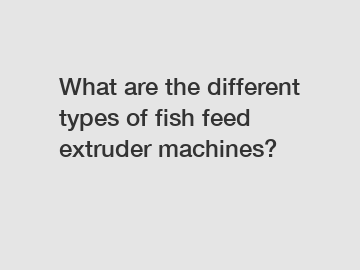What are the different types of fish feed extruder machines?
The aquaculture industry has rapidly expanded over the years, thanks to the increasing demand for fish products. Central to this expansion is the technology-driven innovation in fish feed production. Fish feed extruder machines have revolutionized the industry, ensuring efficient, consistent, and cost-effective manufacturing of fish feed. In this article, we delve into the different types of fish feed extruder machines, exploring their unique features, benefits, and applications.
1. Single-Screw Extruder Machines.
Single-screw extruders are a popular choice for fish feed production due to their versatility and simplicity. These machines consist of a single rotating screw inside a cylindrical barrel. As raw material enters the extruder, the screw pushes it forward, generating heat and pressure while simultaneously cooking the ingredients. This thermal process enhances the quality and digestibility of the feed.

Single-screw extruder machines can adjust their parameters accordingly, such as the rotational speed and temperature, allowing for precise control over the extrusion process. They are well-suited for producing a wide range of floating and sinking fish feeds, optimizing nutrient retention and promoting fish health.
2. Twin-Screw Extruder Machines.
Twin-screw extruders boast two intermeshing screws rotating in the same direction. These machines are known for their exceptional processing capabilities, enabling efficient mixing, shearing, and cooking of feed ingredients. The twin-screw configuration facilitates a higher degree of customization, allowing manufacturers to control various parameters, such as screw speed, temperature, and moisture content.
The versatility of twin-screw extruders allows for the production of a diverse range of fish feed products, including floating, semi-floating, and sinking feeds. These extruders excel in accommodating different raw materials, such as grains, fish meal, oils, and additives, with precise control over the formulation process.
3. Wet Type Fish Feed Extruder Machines.
Wet type extruders specialize in producing high-quality fish feeds with a high moisture content. This type of extruder relies on water as a lubricant, cooling agent, and medium for binding the feed ingredients together. The wet extrusion process involves preconditioning, where the raw materials are initially mixed and cooked before undergoing extrusion. The resultant paste-like mixture is then extruded through the die plates to form fish feed pellets.
Wet type extruders are valued for their ability to produce highly palatable and easily digestible fish feeds. They are commonly used in the manufacturing of floating fish feeds, widely favored for their nutritional value and reduced environmental impact.
4. Dry Type Fish Feed Extruder Machines.
Dry type extruders are designed for producing fish feeds with a low moisture content. These machines utilize heat and pressure alone to cook the ingredients and form the final product. The dry extrusion process enables the manufacture of high-quality sinking fish feeds that are rich in essential nutrients.
Dry type extruders are efficient in producing standardized and stable fish feeds, making them ideal for commercial fish farming operations. These machines offer great flexibility in terms of feed formulation and can process a wide array of raw materials, including grains, soybean meal, fish meal, and more.
Conclusion.
Fish feed extruder machines play a vital role in meeting the growing demands of the aquaculture industry. Selecting the right type of extruder depends on several factors, such as the desired feed composition, required production capacity, and target fish species. Single-screw extruders deliver versatility and simplicity, while twin-screw extruders offer superior performance and customization. Wet type extruders cater to high-moisture feeds, whereas dry type extruders excel in low-moisture sinking feeds.
By harnessing the power of these advanced extrusion technologies, fish feed manufacturers can optimize the nutritional value, digestibility, and overall quality of their products, promoting healthier growth and sustainable aquaculture practices.
Whether you are a small-scale fish farmer or an industrial feed manufacturer, investing in the right fish feed extruder machine can significantly enhance your productivity and profitability, catering to the ever-growing global demand for high-quality fish feeds.
Want more information on feed pellet packing machine, animal feed coating machine, Feed Cleaning Machine? Feel free to contact us.


